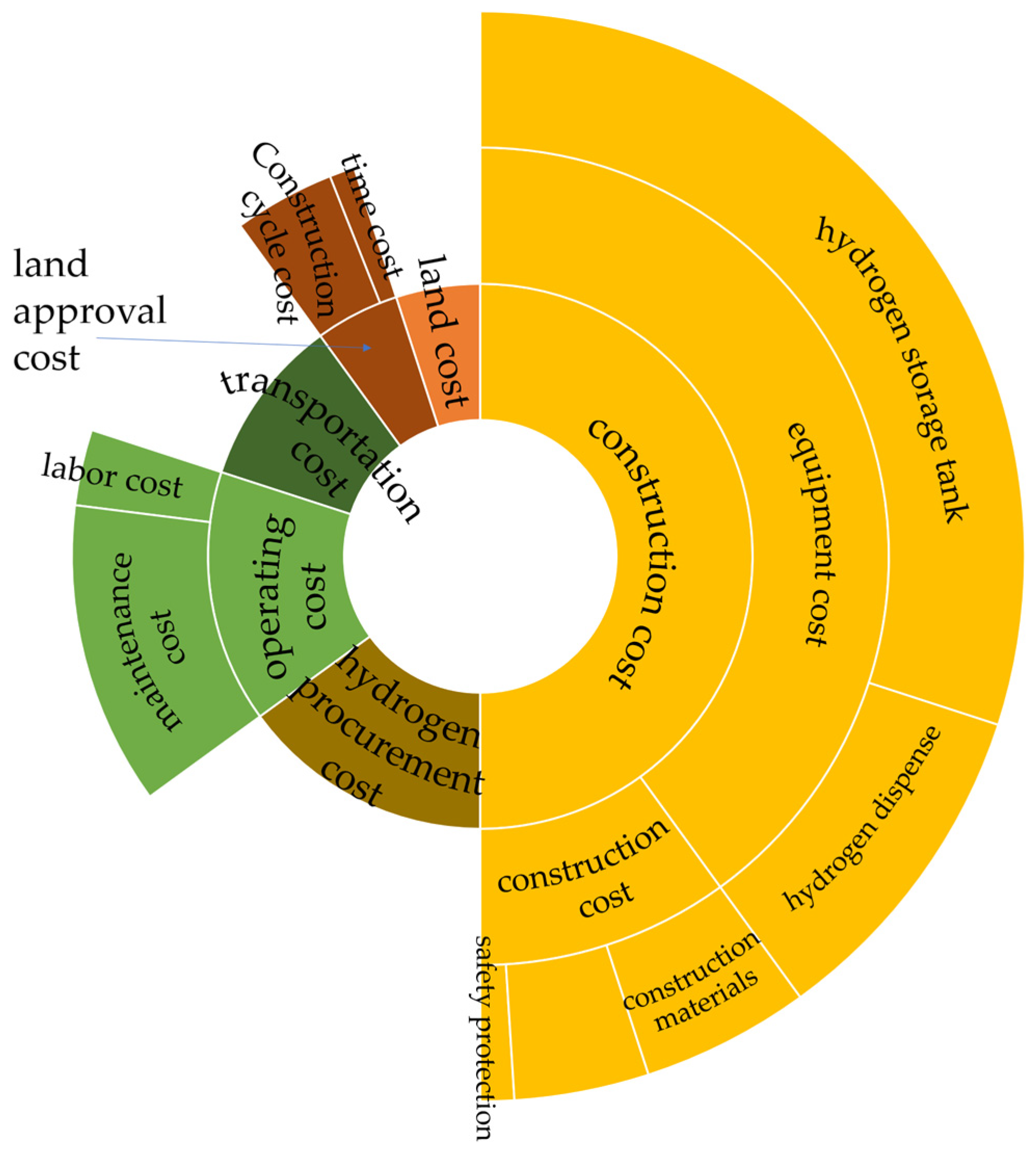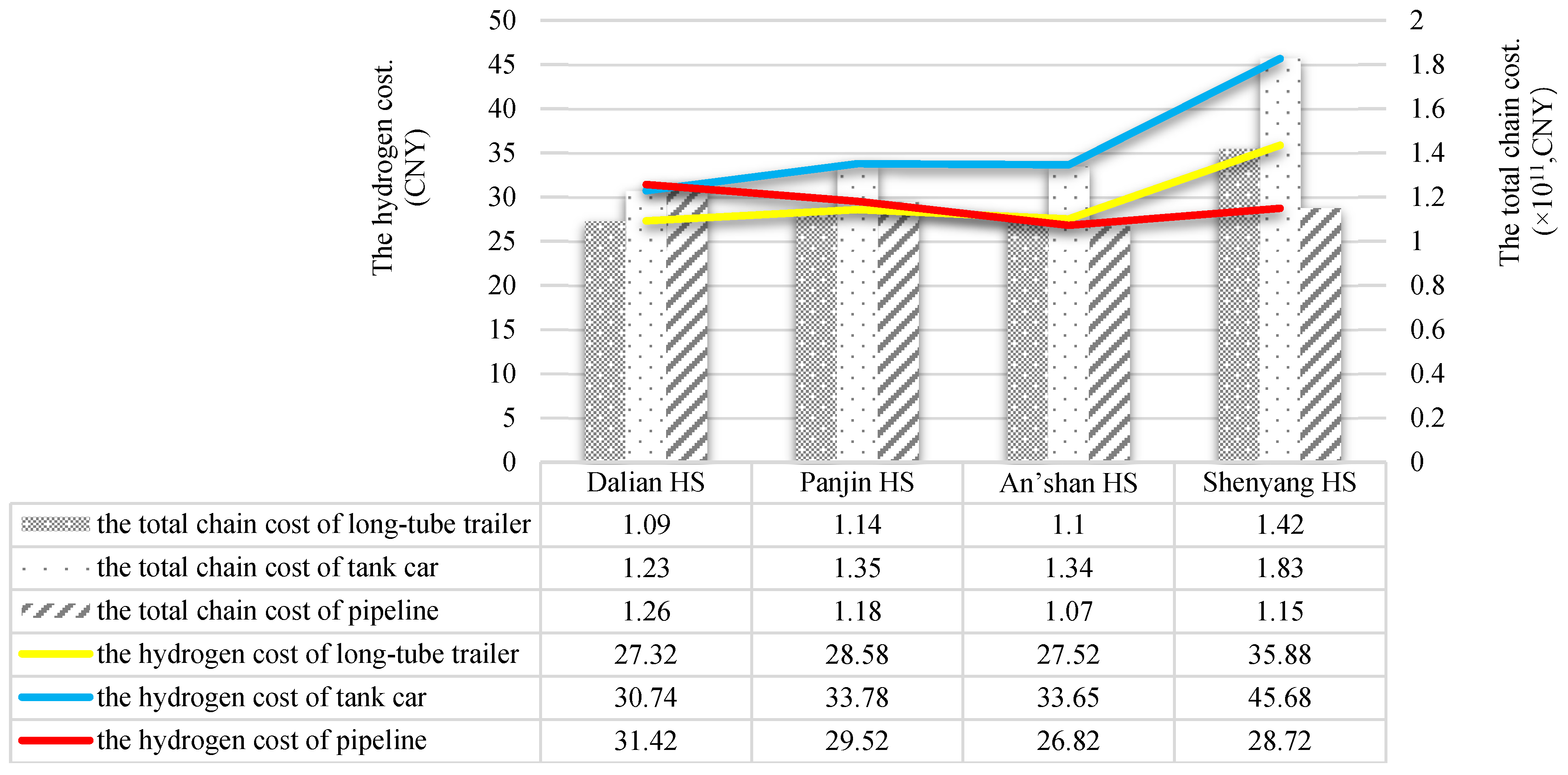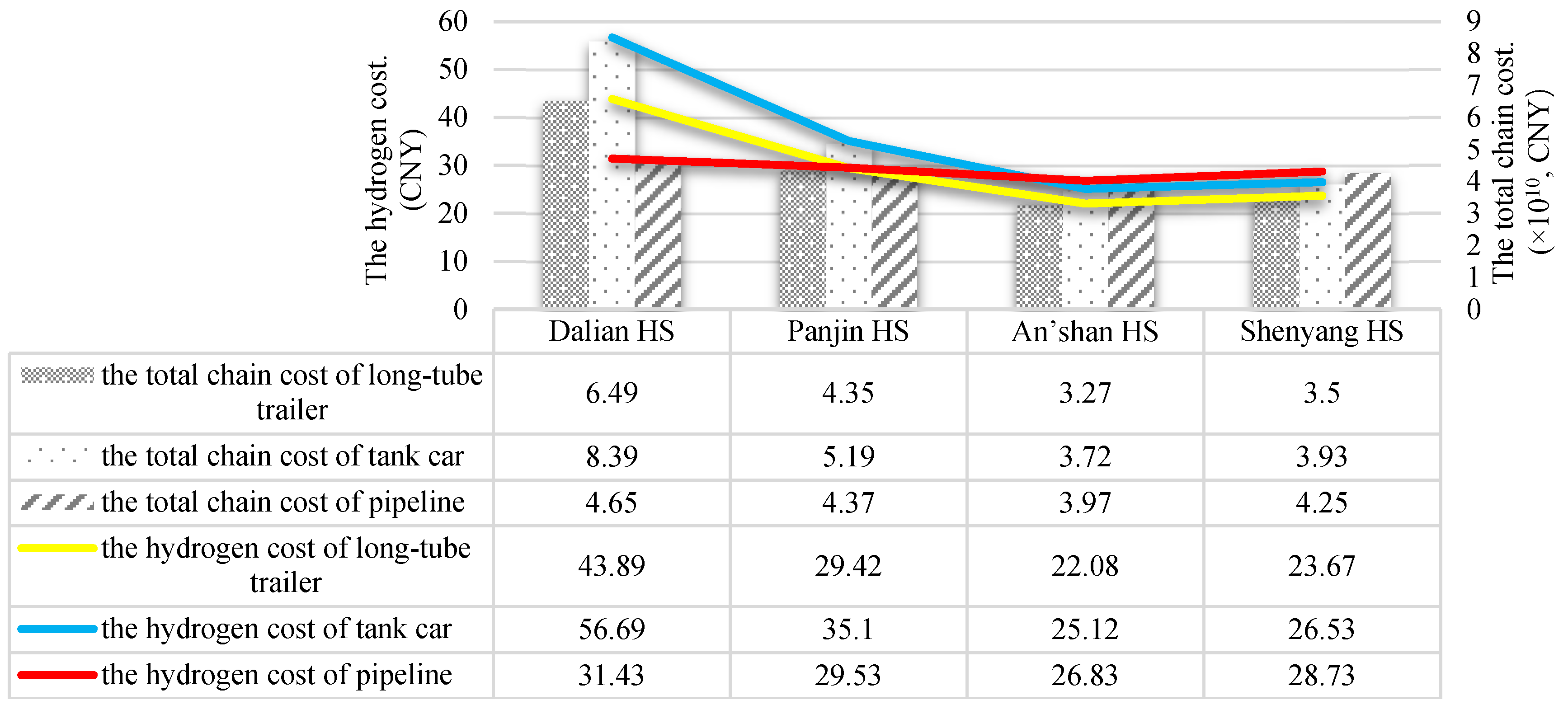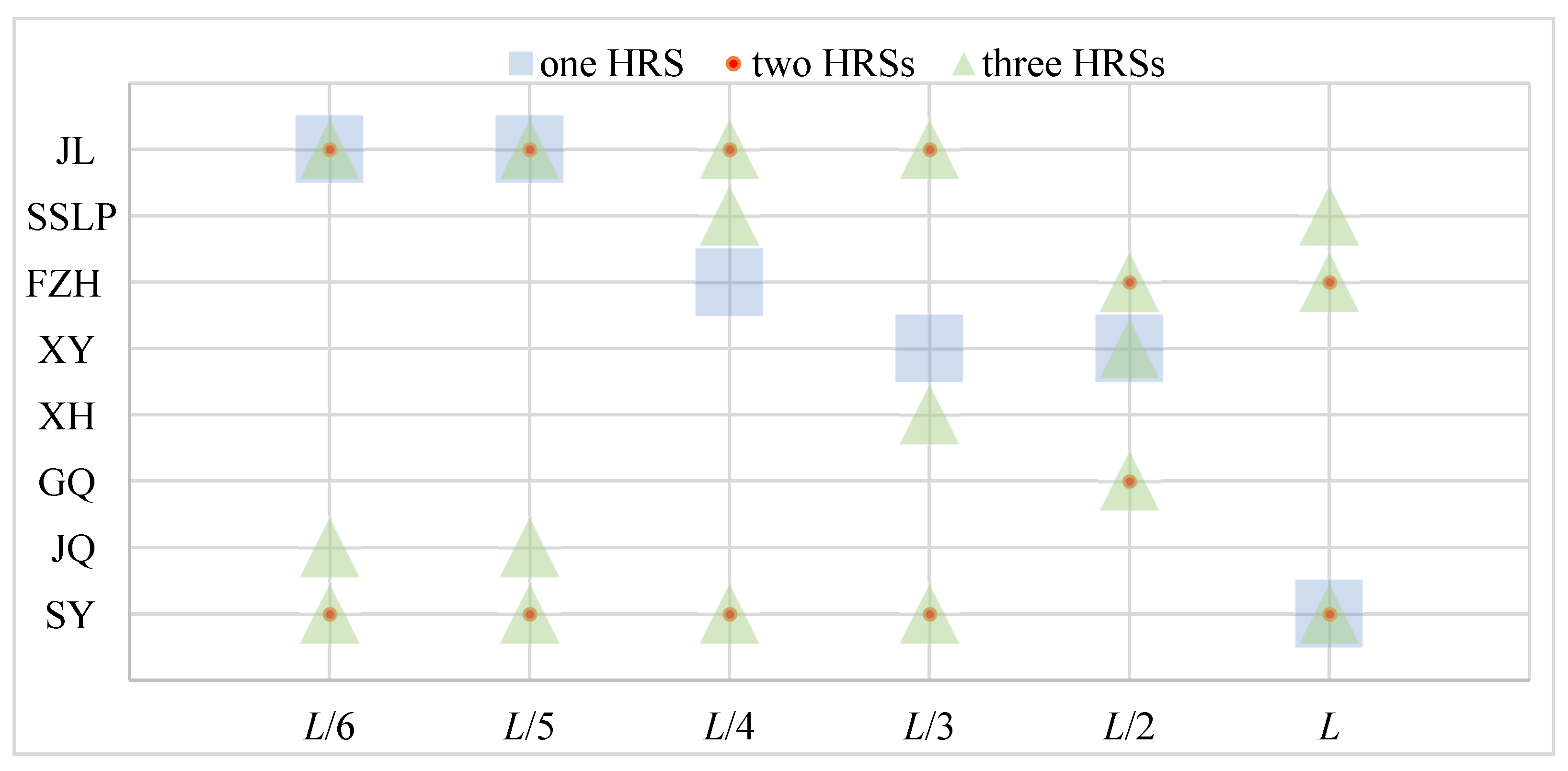A Bi-Level Optimization Model for Hydrogen Station Location Considering Hydrogen Cost and Range Anxiety
Abstract
1. Introduction
2. Literature Review
2.1. Research Progress of HRS Site Selection
2.2. Impact of HRS Construction Cost on Site Selection
2.3. The Impact of Range Anxiety on the Location of HRSs
3. Materials and Methods
3.1. Upper-Level Model
3.2. Lower-Level Model
3.3. Example Analysis—Hydrogen Corridor Data
4. Results
4.1. Results Analysis
4.1.1. Scenario 1
4.1.2. Scenario 2
4.1.3. Scenario 3
4.2. Sensitivity Analysis
5. Discussion
6. Conclusions
Author Contributions
Funding
Data Availability Statement
Conflicts of Interest
Nomenclature
| binary decision variable, taking the value one if a HRS is built at node i, and zero otherwise | |
| binary decision variable, taking the value one if a HFCV stops at node i, and zero otherwise | |
| refueling quantity of a single vehicle at each node i (kg) | |
| the maximum remaining range with full fuel (km) | |
| the maximum remaining range of the FCEV before reaching at node i (km) | |
| the initial remaining range (km) | |
| the shortest path distance between any node i and j (km) | |
| the shortest path distance between node i and HS f (km) | |
| range anxiety threshold, that is, users become anxious when the remaining range of the HFCV will only last for (km) | |
| the scale factor | |
| the range anxiety for a user arrives at node i | |
| budget for the construction of the HRSs (CNY) | |
| land cost of node i (CNY) | |
| unit land cost of node i (CNY) | |
| HRS construction cost (CNY) | |
| hydrogen delivery cost of t-type vehicles between node i and HS f (CNY) | |
| hydrogen delivery cost of pipeline between node i and HS f (CNY) | |
| hydrogen procurement cost (CNY) | |
| fixed cost of building one HRS at node i (CNY) | |
| annual operating cost of node i (CNY) | |
| land area of node i (m2) | |
| unit price of hydrogen (CNY/kg) | |
| unit transportation cost of t-type vehicle (CNY) | |
| levelized cost of pipeline hydrogen transportation (CNY/kg) | |
| hydrogen fuel cell heavy-duty truck load (kg/vehicle) | |
| hydrogen consumption per 100 km of a HFCV (100 km/kg) | |
| annual vehicle flow (vehicle) | |
| hydrogen quantity from the HS f to the node i (kg) | |
| set of potential hydrogen refueling station locations, i∈I, j∈J, and the starting point is represented by 0 | |
| set of hydrogen sources, f ∈ F | |
| HRS | hydrogen refueling station |
| HFCV | hydrogen fuel cell vehicle |
| HHDT | hydrogen fuel cell heavy-duty truck |
| HS | hydrogen source |
| HDM | hydrogen delivery mode |
| JL | service area at Jiuli |
| SSLP | service area at Sanshilipu |
| FZH | service area at Fuzhouhe |
| XY | service area at Xiongyue |
| XH | service area at Xihai |
| GQ | service area at Ganquan |
| JQ | service area at Jingquan |
| SY | gas station at Shenyang |
References
- Liu, J.C.; Ma, X.Y.; Lu, C.R. A three-stage framework for optimal site selection of hybrid offshore wind-photovoltaic-wave-hydrogen energy system: A case study of China. Energy 2024, 313, 133723. [Google Scholar]
- Isaac, N.; Saha, A.K. A review of the optimization strategies and methods used to locate hydrogen fuel refueling stations. Energies 2023, 16, 2171. [Google Scholar] [CrossRef]
- Martins, F.P.; Almaraz, S.D.; Junior, A.B.B.; Azzaro-Pantel, C.; Parikh, P. Hydrogen and the sustainable development goals: Synergies and trade-offs. Ren. Sust. Energy Rev. 2024, 204, 114796. [Google Scholar]
- Zhou, Y.; Qin, X.P.; Mei, W.J.; Yang, W.L.; Ni, M. Multi-period urban hydrogen refueling stations site selection and capacity planning with many-objective optimization for hydrogen supply chain. Int. J. Hydrogen Energy 2024, 79, 1427–1441. [Google Scholar]
- Velmozhina, K.A.; Politaeva, N.A.; Ilin, I.V.; Shinkevich, P.S. Review of modern strategies for the development of hydrogen bioenergy as key areas for achieving sustainable development goals. Int. J. Hydrogen Energy 2024, 70, 729–736. [Google Scholar]
- Calandra, D.; Wang, T.W.; Cane, M.; Alfiero, S. Management of hydrogen mobility challenges: A systematic literature review. J. Clean. Prod. 2023, 410, 137305. [Google Scholar]
- Yan, H.S.; Tan, X.C.; Kong, L.S.; Cheng, Y.L. How China’s transport sector responds to carbon neutrality target: A study from a multi-model comparison analysis. Energy Sustain. Dev. 2025, 85, 101627. [Google Scholar]
- Guan, D.Q.; Wang, B.W.; Zhang, J.G.; Shi, R.; Jiao, K.; Li, L.C.; Wang, Y.; Xie, B.; Zhang, Q.W.; Yu, J.; et al. Hydrogen society: From present to future. Energy Environ. Sci. 2023, 16, 4926–4943. [Google Scholar]
- Yang, C.; Hu, Q. Quantifying fuel cell vehicles and hydrogen refueling station networks in China based on roadmap. Energy Sustain. Dev. 2023, 76, 101265. [Google Scholar]
- Zhu, S. 80% of Global Hydrogen Refueling Stations Are Located in Just Five Countries; Interact Analysis: Wellingborough, UK, 2025. [Google Scholar]
- Sayarshad, H.R. Coordinated routing, charging, and power grid for electric and hydrogen vehicles with renewable energy integration. Renew. Energy 2025, 243, 122572. [Google Scholar]
- Ball, M.; Weeda, M. The hydrogen economy—Vision or reality? Int. J. Hydrogen Energy 2015, 40, 7903–7919. [Google Scholar]
- Winter, C.-J. Hydrogen energy—Abundant, efficient, clean: A debate over the energy-system-of-change. Int. J. Hydrogen Energy 2009, 34, S1–S52. [Google Scholar]
- Lin, R.H.; Ye, Z.Z.; Wu, B.D. A review of hydrogen station location models. Int. J. Hydrogen Energy 2020, 45, 20176–20183. [Google Scholar]
- Hernández, B.; Alkayas, A.; Azar, E.; Mayyas, A.T. Mathematical Model for the Placement of Hydrogen Refueling Stations to Support Future Fuel Cell Trucks. IEEE Access 2021, 9, 148118–148131. [Google Scholar]
- Kim, H.; Kim, B.-I.; Thiel, D. Exact algorithms for incremental deployment of hydrogen refuelling stations. Int. J. Hydrogen Energy 2021, 46, 28760–28774. [Google Scholar]
- Sun, H.R.; He, C.M.; Yu, X.Z.; Wu, M.X.; Ling, Y.H. Optimal siting and sizing of hydrogen refueling stations considering distributed hydrogen production and cost reduction for regional consumers. Int. J. Energy Res. 2019, 43, 4184–4200. [Google Scholar]
- Zhou, Y.; Qin, X.P.; Li, C.L.; Zhou, J. An Intelligent Site Selection Model for Hydrogen Refueling Stations Based on Fuzzy Comprehensive Evaluation and Artificial Neural Network—A Case Study of Shanghai. Energies 2022, 15, 1098. [Google Scholar] [CrossRef]
- Greene, D.L.; Ogden, J.M.; Lin, Z.H. Challenges in the designing, planning and deployment of hydrogen refueling infrastructure for fuel cell electric vehicles. eTransportation 2020, 6, 100086. [Google Scholar]
- Shamsi, H.; Tran, M.-K.; Akbarpour, S.; Maroufmashat, A.; Fowler, M. Macro-Level optimization of hydrogen infrastructure and supply chain for zero-emission vehicles on a Canadian corridor. J. Clean. Prod. 2021, 289, 125163. [Google Scholar]
- Xu, M.J.; Wu, Y.N.; Liao, Y.J.; Tao, Y.; Liu, F.T. Optimal sites selection of oil-hydrogen combined stations considering the diversity of hydrogen sources. Int. J. Hydrogen Energy 2023, 48, 1043–1059. [Google Scholar]
- Stephens-Romero, S.D.; Brown, T.M.; Kang, J.E.; Recker, W.W.; Samuelsen, G.S. Systematic planning to optimize investments in hydrogen infrastructure deployment. Int. J. Hydrogen Energy 2010, 35, 4652–4667. [Google Scholar]
- Markert, F.; Nielsen, S.K.; Paulsen, J.L.; Andersen, V. Safety aspects of future infrastructure scenarios with hydrogen refueling stations. Int. J. Hydrogen Energy 2007, 32, 2227–2234. [Google Scholar] [CrossRef]
- Nicholas, M.A.; Ogden, J. Detailed analysis of urban station siting for California hydrogen highway network. J. Transp. Res. Board 2006, 1983, 121–128. [Google Scholar] [CrossRef]
- Li, S.X.; Long, J.H.; Sui, P.-C.; Hou, Z.X.; Chahine, R.; Xiao, J.S. Addition of hydrogen refueling for fuel cell bus fleet to existing natural gas stations: A case study in Wuhan, China. Int. J. Energ. Res. 2019, 43, 7557–7572. [Google Scholar] [CrossRef]
- Lin, R.H.; Ye, Z.Z.; Guo, Z.Y.; Wu, B.D. Hydrogen station location optimization based on multiple data sources. Int. J. Hydrogen Energy 2020, 45, 10270–10279. [Google Scholar]
- Shi, M.F.; Li, X.M.; Xu, C.B. Two-stage site selection of hydrogen refueling stations coupled with gas stations considering cooperative effects based on the CRITIC-ITFAHPMABAC method: A case study in Beijing. Int. J. Hydrogen Energy 2024, 49, 1274–1292. [Google Scholar]
- Katikaneni, S.P.; Al-Muhaish, F.; Harale, A.; Pham, T.V. On-site hydrogen production from transportation fuels: An overview and techno-economic assessment. Int. J. Hydrogen Energy 2014, 39, 4331–4350. [Google Scholar] [CrossRef]
- Chaudhary, K.; Bhardvaj, K.; Chaudhary, A. A qualitative assessment of hydrogen generation techniques for fuel cell applications. Fuel 2024, 358, 130090. [Google Scholar] [CrossRef]
- Melaina, M.; Penev, M. Hydrogen Station Cost Estimates. Comparing Hydrogen Station Cost Calculator Results with Other Recent Estimates; National Renewable Laboratory (NREL): Denver, CO, USA, 2013. [Google Scholar]
- Noel, L.; Rubens, G.Z.; Sovacool, B.K.; Kester, J. Fear and loathing of electric vehicles: The reactionary rhetoric of range anxiety. Energy Res. Soc. Sci. 2019, 48, 96–107. [Google Scholar] [CrossRef]
- Ala, G.; Miceli, R.; Romano, P.; Schettino, G.; Viola, F. Electric Vehicles and Psychology, Part 2. In Proceedings of the 2021 Sixteenth International Conference on Ecological Vehicles and Renewable Energies, Monte-Carlo, Monaco, 5–7 May 2021; pp. 1–7. [Google Scholar]
- Wang, Z.K.; Zeng, S.K.; Guo, J.B. Understanding the influence of state of health on the range anxiety of battery electric vehicle drivers. IET Intell. Transp. Sy. 2021, 15, 286–296. [Google Scholar] [CrossRef]
- Salah, K.; Kama, N. Reducing Range Anxiety by Unifying Networks of Charging Stations. In Proceedings of the 2016 3rd International Conference on Manufacturing and Industrial Technologies, Istanbul, Turkey, 25–27 May 2016; Volume 70, p. 04003. [Google Scholar]
- Guo, F.; Yang, J.; Lu, J.Y. The battery charging station location problem: Impact of users’ range anxiety and distance convenience. Transport. Res. Part E 2018, 114, 1–18. [Google Scholar]
- Chen, R.; Liu, X.L.; Miao, L.X.; Yang, P. Electric Vehicle Tour Planning Considering Range Anxiety. Sustainability 2020, 12, 3685. [Google Scholar] [CrossRef]
- Xia, L.N.; Chen, C.; Ren, H.H.; Kang, Z.J. Analysis of range anxiety using NEV monitoring big data. In Proceedings of the 2022 ASIA Conference on Algorithms, Computing and Machine Learning, Hangzhou, China, 25–27 March 2022; pp. 145–149. [Google Scholar]
- Fuse, M.; Noguchi, H.; Seya, H. Near-term location planning of hydrogen refueling stations in Yokohama City. Int. J. Energy Res. 2021, 46, 12272–12279. [Google Scholar] [CrossRef]
- Li, J.Y.; Liu, C.Y.; Wang, Y.S.; Chen, R.; Xu, X.S. Bi-level programming model approach for electric vehicle charging stations considering user charging costs. Electr. Pow. Syst. Res. 2023, 214, 108889. [Google Scholar]
- Wu, Q.L.; Li, C.X. Dynamic pricing and energy management of hydrogen-based integrated energy service provider considering integrated demand response with a bi-level approach. J. Energ. Storage 2023, 59, 106558. [Google Scholar]
- Lei, Y.; Zhang, J.; Ren, Z.H. A Study on Bicycle-Sharing Dispatching Station Site Selection and Planning Based on Multivariate Data. Sustainability 2023, 15, 13112. [Google Scholar] [CrossRef]
- Xu, Y.J.; Jia, H.F.; Zhang, Y.K.; Tian, G.D. Analysis on the location of green logistics park based on heuristic algorithm. Advan. Mech. Engin. 2018, 10, 168781401877463. [Google Scholar]
- Zhang, R.C.; Li, J.X.; Shang, Y.Y. Multi-Level Site Selection of Mobile Emergency Logistics Considering Safety Stocks. Appl. Sci. 2023, 13, 11245. [Google Scholar] [CrossRef]
- Zhou, Y.; Qin, X.P.; Yao, C.L.; Ni, M.; Zhou, J.; Liu, L.; Lie, W.Y.; Yang, W.L. Site planning and selection of hydrogen refueling stations considering the life cycle and demand uncertainty. Sustain. Energy Fuels 2023, 23, 5513–5527. [Google Scholar]
- Ga, B.V.; Tu, B.T.M.; Mai, P.X.; Hung, B.V.; Pham, L.H.P. Zero-Emission Vehicles Penetration into the ASEAN Market: Challenges and Perspective. In CIGOS 2021, Emerging Technologies and Applications for Green Infrastructure; Springer: Singapore, 2021; Volume 203, pp. 1733–1742. [Google Scholar]
- Kuby, M.; Lim, S. The flow-refueling location problem for alternative-fuel vehicles. Socio-Econ. Plan. Sci. 2005, 39, 125–145. [Google Scholar]
- Gao, X.W.; An, R.C. Research on the coordinated development capacity of China’s hydrogen energy industry chain. J. Clean. Prod. 2022, 377, 134177. [Google Scholar] [CrossRef]
- Yang, Y.; Tong, L.G.; Yin, S.W.; Liu, Y.X.; Wang, L.; Qiu, Y.N.; Ding, Y.L. Status and challenges of applications and industry chain technologies of hydrogen in the context of carbon neutrality. J. Clean. Prod. 2022, 376, 134347. [Google Scholar] [CrossRef]
- Apostolou, D.; Xydis, G. A literature review on hydrogen refuelling stations and infrastructure. Current status and future prospects. Renew. Sustain. Energy Rev. 2019, 113, 109292. [Google Scholar] [CrossRef]
- Wang, X.T.; Liu, N.N. Research on the construction plan layout of the combined Hydrogen and CNG refueling station. In Proceedings of the 2021 5th International Conference on Advances in Energy, Environment and Chemical Science, Shanghai, China, 26–28 February 2021; Volume 245, p. 01006. [Google Scholar]
- Yao, Y.Z.; Tan, L.Y.; Chen, F.; Pan, A.; Ma, Q.J.; Zhao, J.L. Hydrogen energy industry in China: The current status, safety problems, and pathways for future safe and healthy development. Saf. Sci. 2025, 186, 106808. [Google Scholar] [CrossRef]
- Xue, S.; Zhu, Z. How government policies promote transportation utilization in the national-level hydrogen supply chain: A case of China. Energy Sustain. Dev. 2024, 80, 101457. [Google Scholar] [CrossRef]
- Akhtar, M.S.; Khan, H.; Liu, J.J.; Na, J. Green hydrogen and sustainable development—A social LCA perspective highlighting social hotspots and geopolitical implications of the future hydrogen economy. J. Clean. Prod. 2023, 395, 136438. [Google Scholar] [CrossRef]











| Service Area | Distance (km) | () | () |
|---|---|---|---|
| JL | 31.9 | 207 | 3000 |
| SSLP | 43.8 | 225 | 3000 |
| FZH | 106.5 | 135 | 3000 |
| XY | 158.9 | 204 | 3000 |
| XH | 191.1 | 225 | 3000 |
| GQ | 265.8 | 135 | 3000 |
| JQ | 326.7 | 135 | 3000 |
| SY | 359.1 | 250 | 3000 |
| Dalian HS | Panjin HS | Anshan HS | Shenyang HS | |
|---|---|---|---|---|
| JL | 71.4 | 224.4 | 243.0 | 318.8 |
| SSLP | 62.3 | 214.8 | 231.4 | 306.9 |
| FZH | 31.6 | 156.2 | 175.0 | 249.7 |
| XY | 69.5 | 105.9 | 124.9 | 199.5 |
| XH | 100.5 | 81.2 | 92.7 | 170.3 |
| GQ | 174.1 | 59.5 | 20.0 | 95.9 |
| JQ | 235.6 | 98.8 | 38.5 | 37.5 |
| SY | 260.7 | 115.6 | 62.0 | 58.4 |
| Dalian HS | Panjin HS | Anshan HS | Shenyang HS | |
|---|---|---|---|---|
| the unit price p | 21.3 | 19.4 | 16.7 | 18.6 |
| HDM | Transport Capacity α: Kg/Vehicle | Unit Price of T-Type HDM : CNY/(Kg·Km) | Pipeline Levelized Cost Below 150 Km : CNY/Kg |
|---|---|---|---|
| long-tube trailer | 350.00 | 866.00 | — |
| tank car | 4000.00 | 1357.00 | — |
| Pipeline | — | — | 10.12 |
| Node i | JL | SSLP | FZH | XY | XH | GQ | JQ | SY | JQ | GQ | XH | XY | FZH | SSLP | JL |
|---|---|---|---|---|---|---|---|---|---|---|---|---|---|---|---|
| no refueling | 468.1 | 456.2 | 393.5 | 341.1 | 308.9 | 234.2 | 173.3 | 128.6 | 83.9 | 23.0 | −51.7 | — | — | — | — |
| refueling at GQ | 468.1 | 456.2 | 393.5 | 341.1 | 308.9 | 234.2 | 173.3 | 128.6 | 83.9 | 23.0 | 425.3 | 393.1 | 340.7 | 278.0 | 266.1 |
| refueling at JQ | 468.1 | 456.2 | 393.5 | 341.1 | 308.9 | 234.2 | 173.3 | 128.6 | 83.9 | 439.1 | 364.4 | 332.2 | 279.8 | 217.1 | 205.2 |
| refueling at SY | 468.1 | 456.2 | 393.5 | 341.1 | 308.9 | 234.2 | 173.3 | 128.6 | 455.3 | 394.4 | 319.7 | 287.5 | 235.1 | 172.4 | 160.5 |
| Node i | JL | SSLP | FZH | XY | XH | GQ | JQ | SY | JQ | GQ | XH | XY | FZH | SSLP | JL | Total |
|---|---|---|---|---|---|---|---|---|---|---|---|---|---|---|---|---|
| range anxiety | 0 | 0 | 0 | 0 | 0 | 0 | 0 | 0.13 | 0.20 | 0.72 | ∞ | — | — | — | — | — |
| 0 | 0 | 0 | 0 | 0 | 0 | 0 | 0.13 | 0.20 | 0.72 | 0 | 0 | 0 | 0 | 0 | 1.05 | |
| 0 | 0 | 0 | 0 | 0 | 0 | 0 | 0.13 | 0.20 | 0 | 0 | 0 | 0 | 0 | 0 | 0.33 | |
| 0 | 0 | 0 | 0 | 0 | 0 | 0 | 0.13 | 0 | 0 | 0 | 0 | 0 | 0 | 0.10 | 0.23 |
| One HRS | Two HRSs | Three HRSs | ||
|---|---|---|---|---|
| L | HS | SY: Anshan HS | FZH:—SY: Anshan HS | SSLP:—FZH:—SY: Anshan HS |
| HDM | SY: Long-tube trailer | FZH:—SY: Long-tube trailer | SSLP:—FZH:—SY: Long-tube trailer | |
| The total chain cost (CNY). | SY: 3.57 × 1010 | FZH: 1.44 × 107 SY: 3.57 × 1010 | SSLP: 1.46 × 107 FZH: 1.44 × 107 SY: 3.57 × 1010 | |
| The hydrogen cost (CNY). | SY: 22.08 | FZH:—SY: 22.08 | SSLP:—FZH:—SY: 22.08 | |
| HS | XY: Anshan HS | FZH: Anshan HS GQ: Anshan HS | FZH: Anshan HS XY:—GQ: Anshan HS | |
| HDM | XY: Pipeline | FZH: pipeline GQ: long-tube trailer | FZH: pipeline XY:—GQ: long-tube trailer | |
| The total chain cost (CNY). | XY: 9.75 × 1010 | FZH: 3.73 × 1010 GQ: 3.57 × 1010 | FZH:3.73 × 1010 XY: 1.46 × 107 GQ: 2.98 × 1010 | |
| The hydrogen cost (CNY). | XY: 26.82 | FZH: 26.82 GQ: 22.08 | FZH: 26.82 XY:—GQ: 22.08 | |
| HS | XY: Anshan HS | SSLP: Anshan HS SY: Anshan HS | JL: Anshan HS XH:—SY: Anshan HS | |
| HDM | XY: Pipeline | JL: pipeline GQ: long-tube trailer | JL: pipeline XH:—SY: long-tube trailer | |
| The total chain cost (CNY). | XY: 1.07 × 1011 | SSLP: 8.23 × 1010 SY: 3.27 × 1010 | JL:8.24 × 1010 XH: 1.47 × 107 SY: 3.27 × 1010 | |
| The hydrogen cost (CNY). | XY: 26.82 | SSLP: 26.82 SY: 22.08 | JL: 26.82 XH:—SY: 22.08 | |
| HS | JL: Anshan HS SY: Anshan HS | JL: Anshan HS SSLP:—SY: Anshan HS | ||
| HDM | JL: pipeline SY: long-tube trailer | JL: pipeline SSLP:—SY: long-tube trailer | ||
| The total chain cost (CNY). | JL: 6.61 × 1010 SY: 2.30 × 1010 | JL: 8.72 × 1010 SSLP: 1.47 × 1010 SY: 3.27 × 1010 | ||
| The hydrogen cost (CNY). | JL: 26.82 SY: 22.08 | JL: 26.82 SSLP:—SY: 22.08 | ||
| HS | JL: Anshan HS SY: Anshan HS | JL: Anshan HS JQ:—SY: Anshan HS | ||
| HDM | JL: pipeline SY: long-tube trailer | JL: pipeline JQ:—SY: long-tube trailer | ||
| The total chain cost (CNY). | JL: 9.02 × 1010 SY: 3.27 × 1010 | JL: 9.02 × 1010 JQ: 1.44 × 107 SY: 3.27 × 1010 | ||
| The hydrogen cost (CNY). | JL: 26.82 SY: 22.08 | JL: 26.82 JQ:—SY: 22.08 | ||
| HS | JL: Anshan HS SY: Anshan HS | JL: Anshan HS JQ:—SY: Anshan HS | ||
| HDM | JL: pipeline SY: long-tube trailer | JL: pipeline JQ:—SY: long-tube trailer | ||
| The total chain cost (CNY). | JL: 9.21 × 1010 SY: 3.27 × 1010 | JL: 9.21 × 1010 JQ: 1.44 × 107 SY: 3.27 × 1010 | ||
| The hydrogen cost (CNY). | JL: 26.82 SY: 22.08 | JL: 26.82 JQ:—SY: 22.08 |
Disclaimer/Publisher’s Note: The statements, opinions and data contained in all publications are solely those of the individual author(s) and contributor(s) and not of MDPI and/or the editor(s). MDPI and/or the editor(s) disclaim responsibility for any injury to people or property resulting from any ideas, methods, instructions or products referred to in the content. |
© 2025 by the authors. Licensee MDPI, Basel, Switzerland. This article is an open access article distributed under the terms and conditions of the Creative Commons Attribution (CC BY) license (https://creativecommons.org/licenses/by/4.0/).
Share and Cite
Jiang, L.; Wang, L. A Bi-Level Optimization Model for Hydrogen Station Location Considering Hydrogen Cost and Range Anxiety. Sustainability 2025, 17, 3210. https://doi.org/10.3390/su17073210
Jiang L, Wang L. A Bi-Level Optimization Model for Hydrogen Station Location Considering Hydrogen Cost and Range Anxiety. Sustainability. 2025; 17(7):3210. https://doi.org/10.3390/su17073210
Chicago/Turabian StyleJiang, Lisha, and Liang Wang. 2025. "A Bi-Level Optimization Model for Hydrogen Station Location Considering Hydrogen Cost and Range Anxiety" Sustainability 17, no. 7: 3210. https://doi.org/10.3390/su17073210
APA StyleJiang, L., & Wang, L. (2025). A Bi-Level Optimization Model for Hydrogen Station Location Considering Hydrogen Cost and Range Anxiety. Sustainability, 17(7), 3210. https://doi.org/10.3390/su17073210






